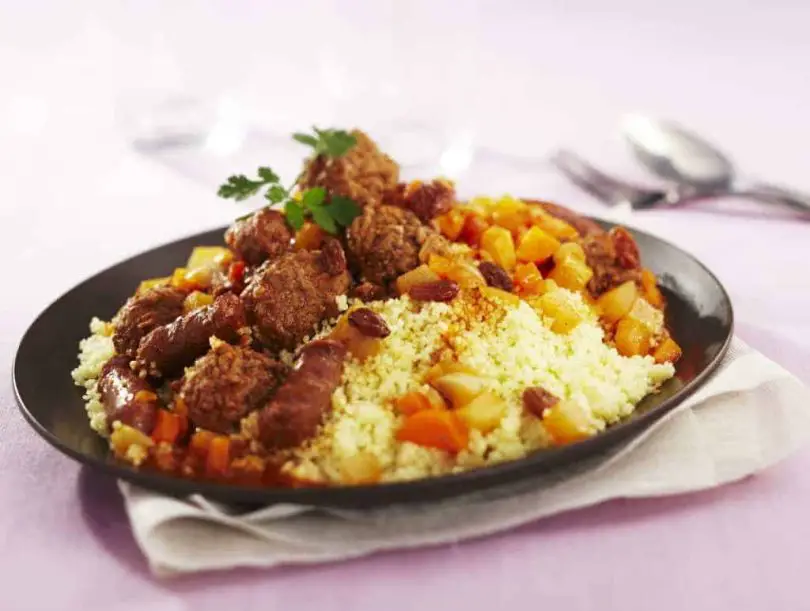Tunisian culture is interesting on many fronts. It carries rich French-Islam-Arabian influence and its location raises questions on if it truly belongs in Africa. But the biggest puzzle is what food is Tunisia famous for with such blended cultural influences?
A majority of its population, 99.1% are Sunni Muslims which is the most dominant faith in the Islamic religion. Less than 1% are either Christians or Jews. Although they are a minority, they have an admirable influence on Tunisian culture extending to cuisine.
Table of Contents
What Food is Tunisia Famous for?
Kosksi or couscous is the most popular food in Tunisia. It is the national dish in this North African country whose popularity lives on a century later. Food enthusiasts attribute the love for couscous to the Arabian-African influence which trickles down to its preparation. The history behind this semolina pasta dish encapsulates what food is Tunisia famous for.

Popular Tunisian delicacies in one plate. Photo/Wikipedia
Couscous comes from tiny steamed balls of semolina. Semolina itself is a coarse flour made from durum wheat, giving couscous its unique texture and slightly nutty flavor. Kuskus is an Arabic name meaning pounding which Arabs borrowed the French in the 17th century. Interestingly, a dive deep in history suggests that its natural origin traces back to the Berbers who inhabit North Africa.
What is the National Dish of Tunisia?
Koski/couscous is Tunisia’s national food with multiple ways to prepare it. It is prepared in a unique style of double boiler known as a couscoussière in French or kiskas in Arabic usually from fine-grained couscous. This little granule, known as kosksi in Tunisia’s national dialect is prepared from dried and cooked durum wheat.
Any occasion calls for couscous, further driving delectable proof of what food is Tunisia famous for because its accompaniment includes meat and vegetables. In addition, it is served in large traditional bowls. The lower pot has slow-cooking vegetables and seasoned meat. Steam from cooking rises through vents and enters the container above. It has a layer of entire herbs, like bay leaves, and a fine-grain couscous on top.
As a result, fragrant steam cooks the couscous noodles. Similar to how risotto is cooked, frequently toss the couscous with a fork during cooking to avoid lumping. You always enjoy it in every social event you walk into in every corner of Tunisia. Weddings, funerals, and family gatherings always feature this dish.
What do Tunisians Eat for Breakfast?
Did you know that Tunisians by default stick to a variety of incredibly healthy meals throughout the day? Breakfast in Tunis and even the remotest village here often has eggs, diaries, dates and honey. However, the cold season invites a national breakfast food known as droa, Arabian meals meaning food with spices.

Tunisian breakfast. Photo/Reddit
Usually, the droa has whole spiced food that is very nutritious. It is also among the oldest traditional meals still enjoyed in the 21st century. Popular spices such as cumin, paprika, Harisa, turmeric, cinnamon and black pepper lace up the whole foods to make droa.
What is Bread Called in Tunisia?
The most common name for bread in Tunisa is khobz. Further, in rural areas, especially during Ramadan, there is a special type of bread known as tabouna. The name comes from the clay oven this bread is baked. There are also flatbreads such as mlawi and ftour which are popular across North Africa.
Bread is a Tunisian treasure because it is deeply ingrained as favourite and popular food in every meal.
What Do Tunisians Eat for Lunch?
Lunchtimes in Tunisia are bursting with diversity and taste! The star of the show is couscous, which is best enjoyed either steamed alongside stewed vegetables in maklouba or next to spicy lamb merguez in couscous l’agneau. Sandwiches like fricassé (deep-fried bread with a variety of fillings) or brik à l’oeuf (crispy pastry filled with egg and tuna) are great for a lighter nibble.
Warming the soul are soupy delicacies like ojja, a spicy tomato and egg stew, or chorba, a tomato and meat soup. A welcome crunch is added by salads like mechouia (roasted peppers with harissa), and fresh bread, khobz, is always there, tearing and dipping into everything. Without thé à la menthe, a fragrant mint tea that completes the meal with a delightful symphony, lunch is not quite complete. And so, be it a robust couscous dish or a simple.








